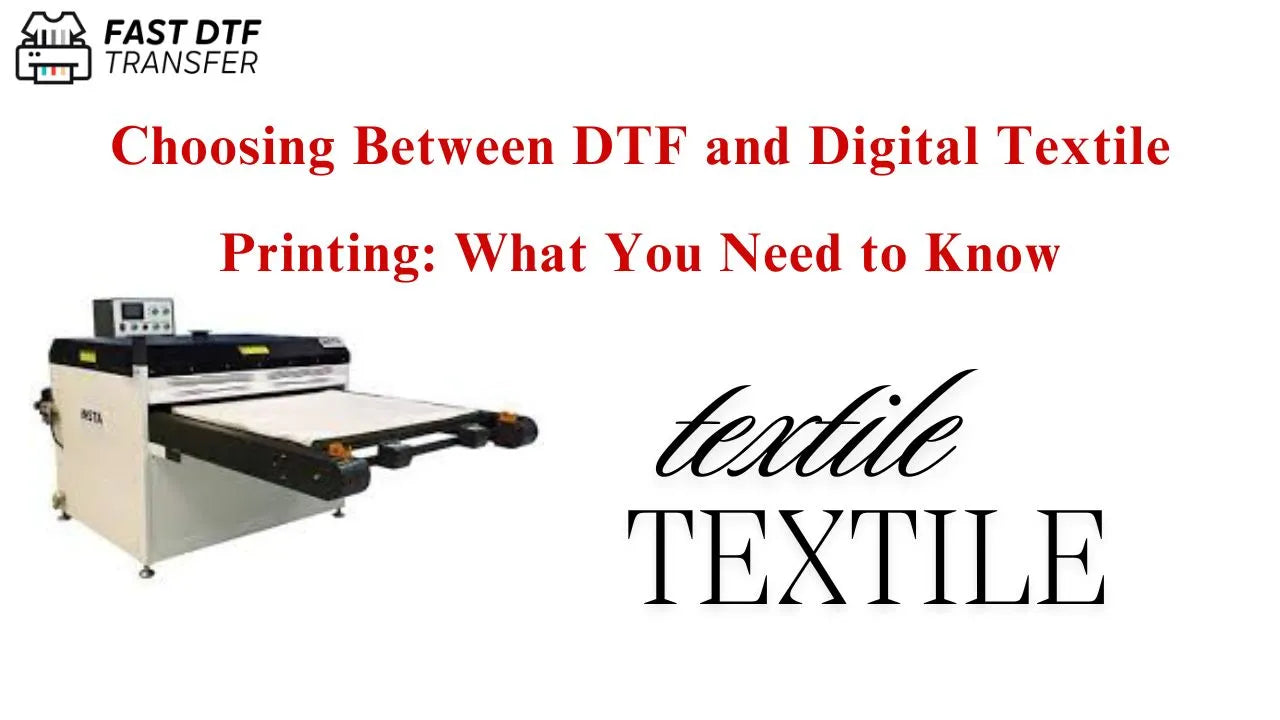
Choosing Between DTF and Digital Textile Printing

DTF and Digital Textile Printing: A Comparison
Both DTF (Direct to Film) and Digital Textile Printing offer flexibility and efficiency, but each method caters to different needs. Let’s compare the two to help you choose the right one for your project.
What Are Direct to Film and Digital Textile Printing?
DTF Printing involves printing a design on a special film, then transferring it to fabric using heat. It allows detailed and vibrant designs on various fabrics.
Digital Textile Printing prints designs directly onto fabric using inkjet printers, ideal for full-color, intricate prints on textiles without screens or plates.
Key Differences Between Direct to Film and Digital Textile Printing
- Printing Process: DTF prints on film and transfers it onto fabric, while digital textile printing prints directly on fabric.
- Materials Used: DTF works on many materials (cotton, polyester, blends), while digital textile printing suits fabrics like cotton, silk, and synthetics.
- Durability: DTF prints are very durable, resisting wear and washing. Digital textile prints are durable but may need post-treatment.
- Design Complexity: Digital textile printing supports intricate designs directly on fabric, whereas DTF requires a transfer step.
Benefits of Direct to Film Printing
- High-Quality Prints: DTF produces vibrant, sharp designs ideal for custom apparel and accessories.
- Versatility: It works on various fabrics, from cotton to leather, perfect for custom products.
- Durability: DTF prints resist washing and fading, staying vibrant for longer.
Benefits of Digital Textile Printing
- Direct Printing on Fabric: Prints are seamlessly integrated into fabric, offering better softness and feel.
- Unlimited Colors: Digital printing allows full-color prints without additional costs.
- Environmental Benefits: It uses less water and generates less waste than traditional methods.
Which Printing Method Should You Choose?
- Choose DTF if you need versatile fabric options, enhanced durability, and vibrant designs on multiple textiles.
- Choose Digital Textile Printing if you prefer direct fabric printing, unlimited colors, and eco-friendly options.
Conclusion
Both methods offer unique benefits. DTF is perfect for flexibility and durability, while digital textile printing is great for direct prints and full-color designs. Consider your needs to select the best method for your custom textile printing project.
1. What is the difference between Direct to Film and Digital Textile Printing?
Direct to Film prints a design onto a special film, which is then transferred onto fabric using heat and pressure. Digital Textile Printing prints designs directly onto fabric using inkjet printers, eliminating the need for transfer films.
2. What types of fabrics can I print on with Direct to Film and Digital Textile Printing?
Direct to Film printing is versatile and can be used on various fabrics, including cotton, polyester, leather, and blends. Digital Textile Printing is generally used on natural fabrics like cotton, silk, and synthetics.
3. Which method provides better durability?
Direct to Film printing provides highly durable prints that resist wear and washing. Digital Textile Printing is also durable but may require additional post-treatment for certain fabrics to ensure longevity.
4. Can both methods print in full color?
Yes, both methods can print full-color designs. Digital Textile Printing excels at high-resolution, complex designs, while DTF printing can handle vibrant, detailed designs with the added step of transferring the print onto fabric.
5. Which method is more eco-friendly?
Digital Textile Printing is often considered more eco-friendly because it uses less water and produces fewer chemical waste products compared to traditional screen printing methods. Direct to Film printing can also be environmentally friendly depending on the inks and processes used.
6. Is DTF printing suitable for dark fabrics?
Yes, DTF printing is ideal for dark fabrics because it uses white ink as a base, ensuring that vibrant colors appear clearly even on dark or black materials. Digital Textile Printing can also print on dark fabrics but may need different ink formulations.
7. Which method is better for small orders or custom prints?
DTF printing is great for small batches and custom orders because it’s faster and more cost-effective, especially for designs that need to be transferred onto a wide range of fabrics. Digital Textile Printing is better for larger runs where intricate, full-color designs are required.
8. Which method is easier to learn for beginners?
DTF printing might be easier for beginners to learn, especially if you already have experience with heat press machines. Digital Textile Printing can be more complex as it involves direct printing onto fabric and may require specialized ink and printer maintenance.
9. What are the main benefits of Digital Textile Printing over Direct to Film?
Digital Textile Printing offers better fabric integration, creating prints that are more seamlessly embedded into the fabric, which makes them softer. It also has the advantage of printing in unlimited colors without additional costs for complex designs.
10. Which printing method is best for high-volume production?
Digital Textile Printing is generally better for high-volume production, as it allows for direct printing on fabric and can handle larger runs efficiently. DTF printing is great for small to medium runs and offers flexibility in fabric choices.
Check Out Our Other Products
More information

